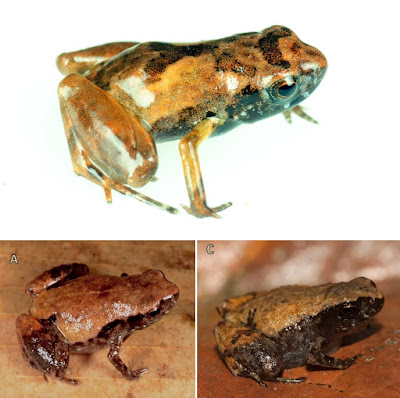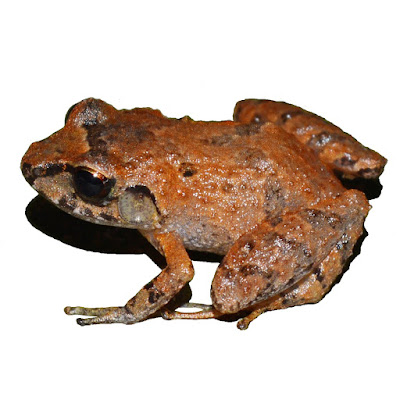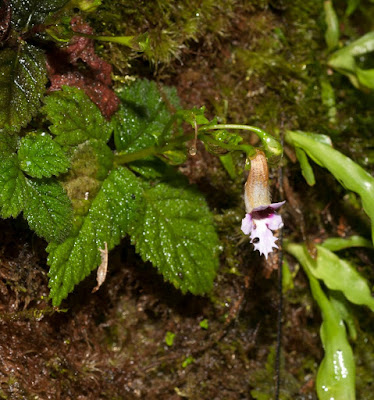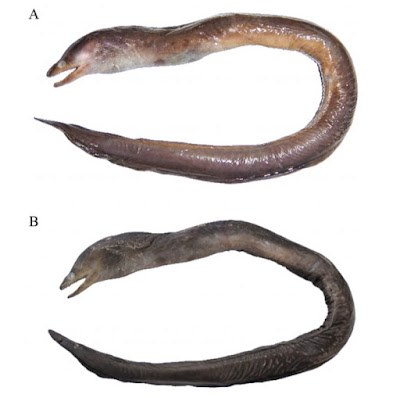[Most Recent Entries] [Calendar View]
Tuesday, August 27th, 2019
| Time | Event | ||||
| 2:02a | [Herpetology • 2019] Noblella losamigos • A New Species of Terrestrial-Breeding Frog (Strabomantidae, Noblella) from the Upper Madre De Dios Watershed, Amazonian Andes and Lowlands of Southern Peru
Abstract We describe and name a new species of Noblella Barbour, 1930 (Strabomantidae) from southern Peru. Key diagnostic characteristics of the new species include the presence of a short, oblique fold-like tubercle on the ventral part of the tarsal region, two phalanges on finger IV, and an evident tympanum. The elevational distribution of the new species spans 1250 m (240–1490 m) from lowland Amazon rainforest to montane forest on the eastern slopes of the Andes. Keywords: amphibians; ecomorphology; miniaturization; systematics; taxonomy
Noblella losamigos sp. n. Diagnosis: A new species of Noblella characterized by (1) skin on dorsum smooth to finely shagreen, skin on belly smooth, discoidal fold absent, dorsolateral folds absent; (2) tympanic annulus visible below skin, with the upper portion (1/4) covered by a supratympanic fold; tympanic membrane evident; columella present (Figure 6); (3) snout short, rounded in dorsal view and bluntly rounded to subtruncate in profile; (4) upper eyelid with minute tubercles, cranial crests absent; (5) dentigerous process of vomers absent; (6) vocal slits present; nuptial pads absent; .... Etymology: The specific epithet is a toponym used in apposition and it refers to the type locality. Los Amigos Biological Station is located next to Los Amigos Conservation Concession, on the lower Los Amigos River watershed. Both the station and the conservation concession were established by the Amazon Conservation Association, which is a nonprofit organization that (along with its Peruvian counterpart, Conservación Amazónica—ACCA) promotes scientific research, education, and conservation in the western Amazon. Roy Santa-Cruz, Rudolf von May, Alessandro Catenazzi, Courtney Whitcher, Evaristo López Tejeda and Daniel L. Rabosky. 2019. A New Species of Terrestrial-Breeding Frog (Amphibia, Strabomantidae, Noblella) from the Upper Madre De Dios Watershed, Amazonian Andes and Lowlands of Southern Peru. Diversity. 11; 0145. DOI: 10.3390/d11090145 New species of minute leaf-litter frog from Peru - Catenazzi Lab CatenazziLab.org/1/post/2019/08/new-species-of-minut | ||||
| 9:56a | [Herpetology • 2019] Pristimantis nelsongalloi • A New Species of Terrestrial-breeding Frog of the Genus Pristimantis (Anura: Terrarana: Craugastoridae) from the eastern Andean Slopes of the southern Ecuador
Abstract A new frog of the genus Pristimantis is described from a montane cloud forest at 9 de Octubre (2°14’52” S, 78°16’37” W; 1778 m) province of Morona Santiago in the upper basin of the Upano River, southeastern Ecuador. The description of the new species is based on the examination of eleven adult males and three adult females. The new taxon can be readily distinguished from other congeneric species that inhabit the eastern Andes of Ecuador by the unique combination of the following characters: small body (adult males SVL 12.0–17.0 mm, adult females SVL 18.5–21.7 mm); skin of dorsum finely shagreen with two subconical scapular tubercles, weak and discontinuous dorsolateral folds in the middle of the back; large tympanum 70–93% of eye diameter; snout subacuminate in dorsal view, rounded in profile; upper eyelid bearing four or five small and flat supraocular tubercles; males lacking vocal slits and nuptial pads; all discs on fingers and toes lanceolate. Additionally, we provide information on the advertisement call and natural history of the new species. Keywords: Andes, Ecuador, Pristimantis bicantus, Pristimantis nelsongalloi sp. nov., Craugastoridae, Anura, Amphibia Pristimantis nelsongalloi sp. nov. Jorge H. Valencia, Francisco Valladares-Suntasig, Luis Tipantiza-Tuguminago and Manuel R. Dueñas. 2019. A New Species of Terrestrial-breeding Frog of the Genus Pristimantis (Anura: Terrarana: Craugastoridae) from the eastern Andean Slopes of the southern Ecuador. Zootaxa. 4658(3); 509–525. DOI: 10.11646/zootaxa.4658.3.4 | ||||
| 10:18a | [Botany • 2019] Diastema fimbratiloba (Gesneriaceae) • A New Species of Diastema from the eastern Andean Slopes of Peru
Abstract A striking new species of Diastema, D. fimbratiloba, is described from Ucayali Region, along the eastern Andean slopes in central Peru. The new species has a fimbriate lower corolla lobe, a feature not previously documented in the genus. We also provide a general comparison of the newly described species and morphologically related species in the context of the taxonomy and phylogeny of the poorly known genus Diastema. Keywords: Diastema, Gesneriaceae, Peru.
Diastema fimbratiloba Moonlight & J.L.Clark, sp. nov. Etymology. The species is named for the distinctive fimbriations on the lower corolla lobe. Fimbriations are common in several genera of New World Gesneriaceae (especially Drymonia Mart.), but no currently known described species in Diastema is known for this feature. It is possible that other species of Diastema have fimbriate corolla margins (cf. note above regarding the population without collection from Atalaya, Peru), but this is a difficult character to evaluate from collections, because the flowers are delicate and ephemeral. As a result, corolla features in Diastema are not readily available on most herbarium specimens. J. L. Clark and P. W. Moonlight. 2019. A New Species of Diastema (Gesneriaceae) from the eastern Andean Slopes of Peru. Edinburgh Journal of Botany: An International Journal of Plant Systematics and Biodiversity. DOI: 10.1017/S0960428619000192 | ||||
| 10:30a | [Ichthyology • 2019] Gymnothorax andamanensis • A New Short Brown Unpatterned Moray Eel (Muraenidae: Muraeninae) from Andaman waters, India
Abstract Gymnothorax andamanensis sp. nov., a new short brown moray eel, is described here on the basis of two specimens collected from Port Mout, Port Blair, South Andaman (11.659327°N; 92.696148°E), caught using baited hand-lines in a sandy habitat at a depth of less than 2 m. The species is characterized in having the dorsal-fin origin before the gill opening, pre-anal length 2.1–2.2, jaw pores with black rim, two branchial pores, predorsal vertebrae 3, preanal vertebrae 57 and total vertebrae 135–136, teeth smooth, three large fang-like median intermaxillary teeth, biserial maxillary and uniserial vomerine teeth, and dentary teeth biserial with two teeth in each side in the second row of the dentary. The new species is compared with all 10 short brown unpatterned moray eels known from the world and two from Indian waters. Keywords: Anguilliformes, South Andaman, Pisces, new species Anil Mohapatra, R. Kiruba-Sankar, J. Praveenraj and Swarup Ranjan Mohanty. 2019. A New Short Brown Unpatterned Moray Eel Gymnothorax andamanensis (Muraenidae: Muraeninae) from Andaman waters, India. Zootaxa. 4661(1); 189–196. DOI: 10.11646/zootaxa.4661.1.11 | ||||
| 10:44a | [Entomology • 2019] New Taxa of Crickets (Orthoptera: Grylloidea: Gryllinae, Phaloriinae and Pteroplistinae) from northern Borneo (Belait and Sandakan)
Abstract Three species new to science of the Gryllid subfamilies Gryllinae and Pteroplistinae are described from Brunei: (1) Mimicogryllus splendens Tan, Gorochov & Wahab, sp. nov., (2) Pteroplistes bruneiensis Tan, Gorochov & Wahab, sp. nov., and (3) Tembelingiola belaitensis Tan, Gorochov & Wahab, sp. nov. A new species of cricket of the subfamily Phaloriinae is also described from Sandakan, eastern Sabah: Vescelia sepilokensis Tan, Gorochov, Japir & Chung, sp. nov. Keywords: Brunei Darussalam, new species, Sabah, taxonomy, Orthoptera Ming Kai Tan, Andrej V. Gorochov, Rodzay Bin Haji Abdul Wahab, Razy Japir and Arthur Y.C. Chung. 2019. New Taxa of Crickets (Orthoptera: Grylloidea: Gryllinae, Phaloriinae and Pteroplistinae) from northern Borneo (Belait and Sandakan). Zootaxa. 4661(1); 101–117. DOI: 10.11646/zootaxa.4661.1.4 |
| << Previous Day |
2019/08/27 [Calendar] |
Next Day >> |




















